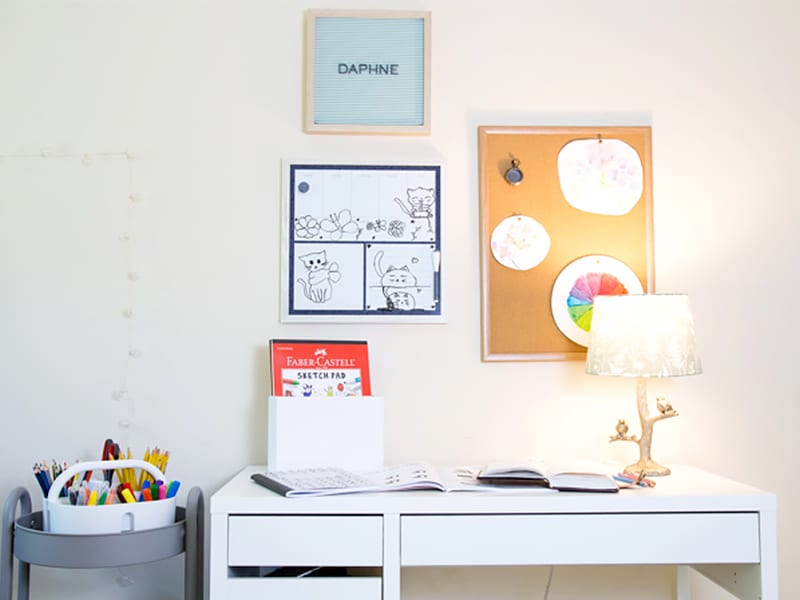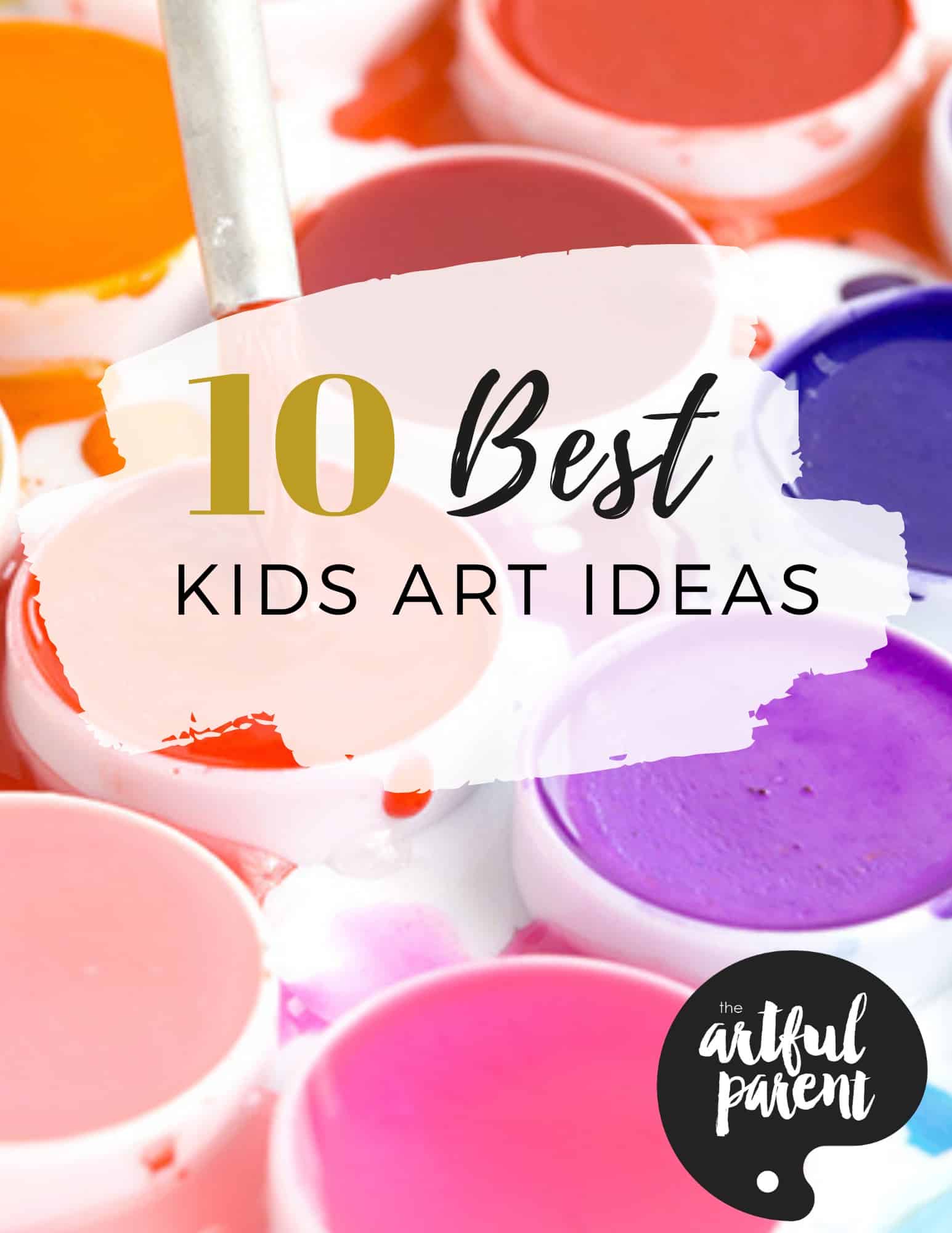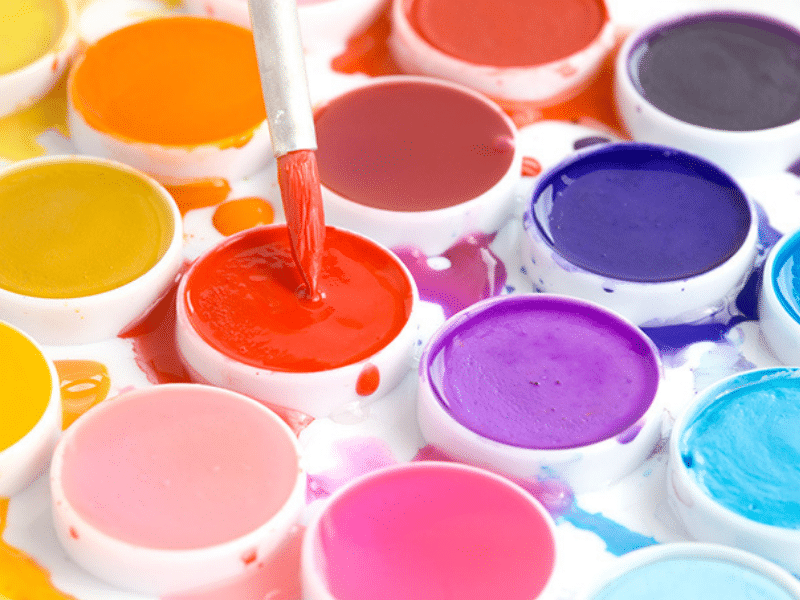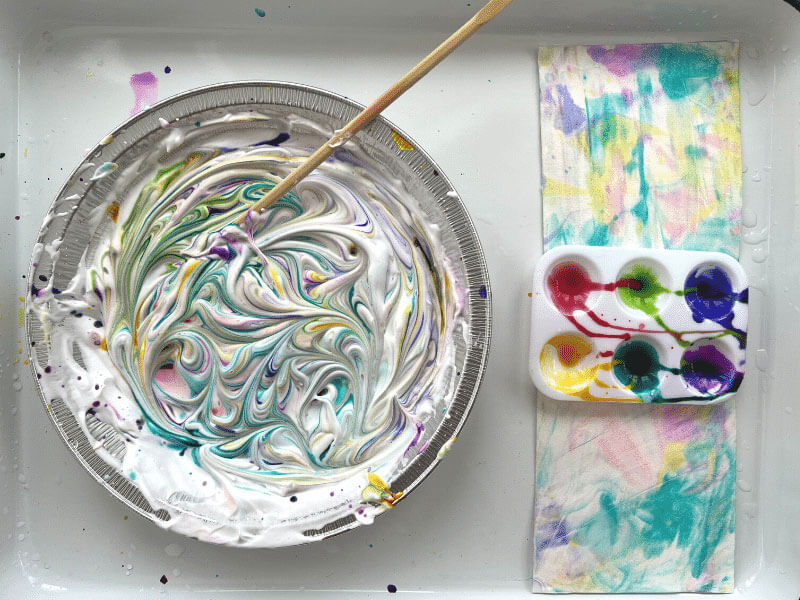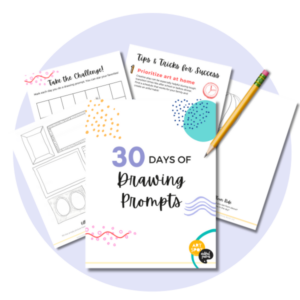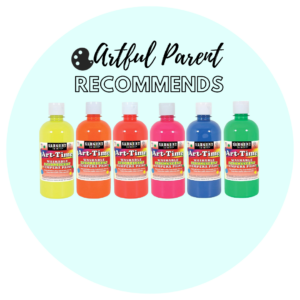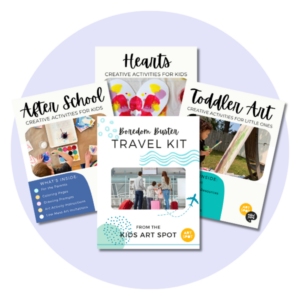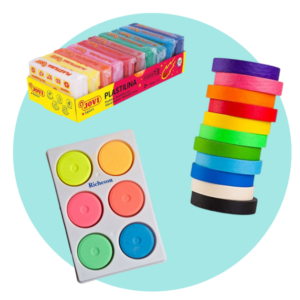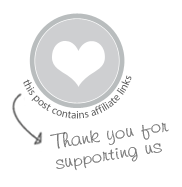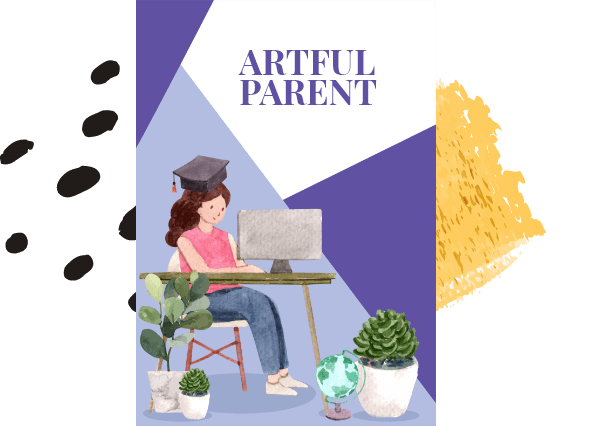In this post, we share 7 steps for setting up an effective kids homework station for school at home and virtual learning this fall. Plus get a free printable guide with checklists & ideas!
Many of our kids will be learning at home again this fall, whether full time, part time, or homeschooling. I know that this is such a challenging situation for so many families and I hope you are able to give yourself and your kids grace amidst it all.
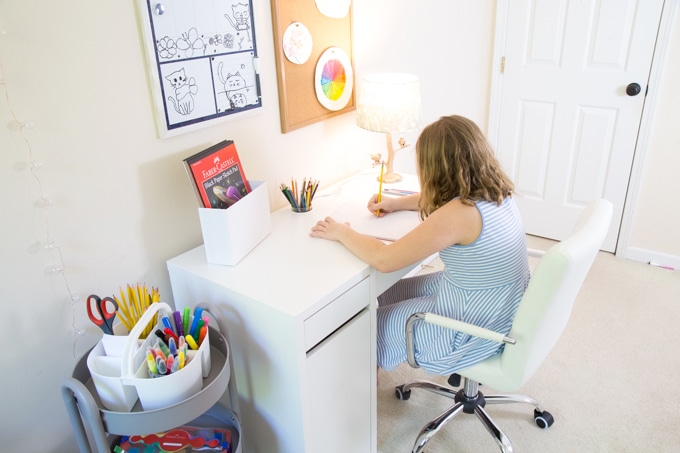
Since many of us will have kids at home at the beginning of this school year, I partnered with Faber-Castell USA to create a post about setting up a kids homework station (or home school desk) for school at home with a variety of tools and supplies to make learning and creating at home as easy as possible.
While a homework station is always a good idea, “home work” is taking on a whole new meaning. It is more important than ever that we are able to create an environment at home that is conducive for learning and that is stocked with the right tools and supplies.

A kids learning station, if you will.
A lot of thought and planning goes into the way classroom environments are set up, by teachers, schools and educational experts. Loris Malaguzzi, founder of the Reggio Emilia school of education, calls environment the “third teacher.”
In this post, I will help parents put a little additional effort into creating a learning environment at home, whether it’s a life-as-usual homework desk or a school-at-home kids homework station.
NOTE: I would like to acknowledge that many families are experiencing varying degrees of financial difficulty right now. I wanted to pull together some ideas that might help your child work from home in peace and harmony. Some of these are free or inexpensive. Some less so. But please know that this post is not created to make anyone feel like they need to have all of these things.
I’ve been thinking carefully about the concept of environment as the third teacher in the context of my own kids’ learning at home. Mine will be going back to learning at home with virtual classrooms, and I know many others will be as well.

What do kids need from their environment in order to learn effectively at home?
For my 10 year old, this means she needs room to write and draw and read. It also means that she needs a space to set up her school laptop and do math assignments or to participate in a Zoom classroom call. She needs a quiet, relatively private place to think and work and participate in virtual instruction. She needs the tools and materials for school assignments as well as for creative expression and stress release.
My teen needs many of the same things, with extra emphasis on privacy and help focusing amidst the bustle of a mixed-age household.
A kindergarten or young elementary school student would do well with a desk or table near a caregiver to practice writing letters, illustrate ideas, and write a few interesting words next to a hand-drawn map of his neighborhood. While they may have some video-based classes as well, I hope that kids this age also have plenty of time and emphasis on hands-on and play-based learning.
For a preschool-aged kid, they need time, space, and support to build with blocks, play with playdough, cut out hand-drawn pictures with scissors, and explore letters and sounds. (For a no-screen preschool option, you might want to consider my friend Ginger Huebner’s Roots + Wings Preschool. Her arts- and play-based preschool is creating home curriculum boxes — Pre-K Little Wings — that they are sending to families all over the country. Each box contains instructions and materials for her tried-and-true preschool activities.)

Let’s Rise to the Challenge
The reality is that this current learning-at-home situation is an imperfect solution to a difficult dilemma and everyone is doing the best they can to rise to the occasion.
- Teachers and schools are doing their absolute best to create connections and provide teaching and learning to their students.
- Kids are doing their best to focus and learn at home in environments and under circumstances that are suddenly very different for many of them, without their friends and peers to play with and learn from.
- Parents and caregivers are doing their best to juggle working at home while facilitating their children’s schoolwork and making space for all of the above while keeping their family safe and happy.
We are all being asked to rise to the challenge of doing things differently right now. For many families, this means helping our kids to learn effectively at home.
With that in mind, here are some ideas for creating a learning environment at home that works best for your family.

7 Tips for Setting Up a Kid’s Homework Station for School at Home
This might look like one main learning station, or it might look like multiple learning stations in the different locations depending on your family situation, the size and layout of your home, and your children’s ages and needs.
1. Set up a desk or work surface for a kids homework station.

If you already have a desk or a work space for your child, great.
If not, here are some ideas.
- You can pick one up at a big box store or furniture store. Or you can order a desk online at places such as Amazon, Wayfair, IKEA, Pottery Barn Kids. We have a couple of these basic MICKE desks from IKEA.
- Or, perhaps there’s a table in your home that you can use as a desk, whether it’s a table you can dedicate to a learning station or the kitchen table that gets to serve multiple purposes throughout the day.
- If you’re handy with a hammer and saw, you can build a homework desk.
- You can even create a makeshift desk by getting a door or a piece of wood and putting it on a couple of sawhorses from Lowes/Home Depot.
- You can search local secondhand sites like Craigslist or Facebook Marketplace, many of whom have safety policies in place.
Okay, now that you have a desk or other work surface, you also need a chair.
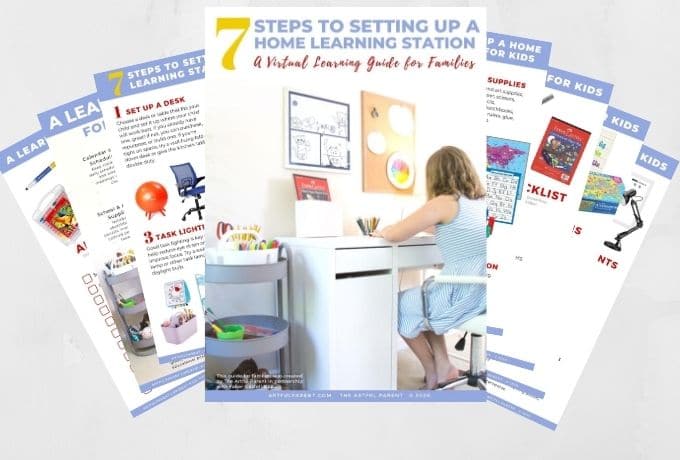
NOTE: Make sure to download the free PDF guide at the end of this post for setting up a home learning station as it includes ideas, checklists, and illustrations.
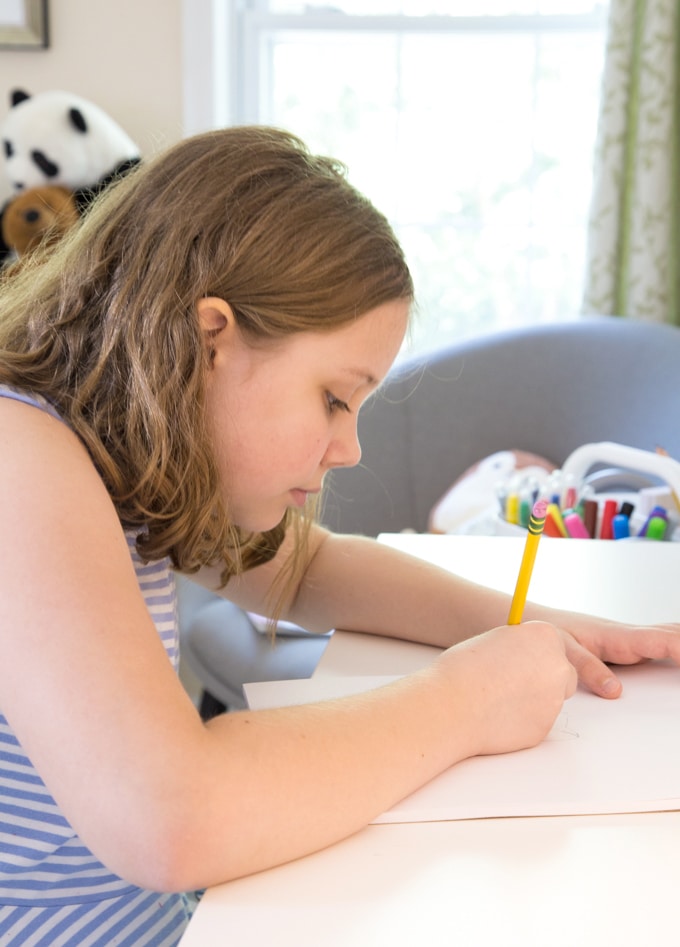
2. Make sure you have a comfortable chair.
Your child’s probably going to be sitting in this chair a lot, so have your child help find a set up that’s comfortable for them.
We had a cheap plastic IKEA chair which served our purpose for a while because Daphne’s desk wasn’t actually used much. But once I realized that this school-at-home situation was likely to last longer than I initially thought (than anyone initially thought!), I agreed to buy the girls both comfortable swivel chairs.
If you’re looking for a good value comfortable swivel chair, here’s one.
We’ve had success with fidget or wobble cushions in the past for child #1, who needed extra help focusing and didn’t like to sit down or sit still.
And I know that some people really like those balance ball chairs for similar reasons.
Anything they can sit on that’s comfortable to work from is fine, though!
3. Ensure Good Lighting
You’ll need good task lighting. If your work area isn’t well lit, try a lamp such as this swing arm desk lamp. Or this one.

4. Stock up on School Supplies & Art Supplies
You’ll need all the normal school and art supplies such as paper, pencils, markers, scissors, and paints. Here are a couple of lists to get you started. And you can find handy printable versions of these checklists (with even more ideas!) in the PDF guide at the bottom of this post.

A List of Basic School Supplies for Your At-Home Work Space
- Pencils
- Pencil sharpener
- Lined paper
- Composition notebooks
- Blank story books
- Blank paper
- Erasers
- Scissors
- Ruler
- Tape
- Glue

A List of Basic Arts & Crafts Supplies
- Colored pencils
- Markers
- Crayons
- Oil pastels
- Watercolor paints
- Tempera paint
- Paint brushes
- Sketch pad
- Colored construction paper
- Sturdy paper for painting
- Modeling clay
- Playdough
- Pipe cleaners
- Pom poms
- Googly eyes
Now that you’ve stocked up on school and art supplies, you might want a way to organize them.

5. Getting Organized
To help your kids learn without being stressed by clutter or by spending a bunch of time trying to find what they need each day, you’ll want to do your best to maintain a clear and organized desk and space. Here are some ideas for organizing your supplies and keeping them off the desk/table as much as possible:

Organize Supplies
- A rolling cart
- An art caddy
- A segmented organizer
- A nearby cupboard, closet, or dresser
- Desk drawers
- Wall-mount paper / file storage
- Wall-mount basket storage

Use the Wall
Use the vertical space provided by the wall closest to the desk or table in order to maximize space.
- Bulletin board
- Whiteboard
- Posters
- Wall mount storage (see above)
Organize Time
Help your child organize their time, from the hours of their days to the days of the week and month with the following ideas:
- Weekly or monthly calendar
- Whiteboard calendar
- Daily schedule or checklist
- A visual timer
- Clock
Now that you’re organized, you may want to consider some additional educational tools or supplies for your child’s at-home learning station or desk.

6. Educational Extensions for Learning at Home
These are additional educational tools and supplies, such as globes, maps, educational posters, and science kits. Things that a classroom might have as part of their learning environment but that we might not usually have at home. These are completely optional, of course, but if you have the budget, it could be worth incorporating one or more of the following:
- Globe
- Maps (world, country, state, constellations, etc)
- Educational posters
- Learning charts (such as the periodic table of elements)
- Atlas
- A children’s dictionary
- A children’s thesaurus
- Microscope or magnifying glass
- Math manipulatives
- Puzzles
- Chemistry set (or other science kit)
Now that your child’s learning station is tricked out with educational tools and supplies, you may want to personalize it to make it extra special and comfortable.
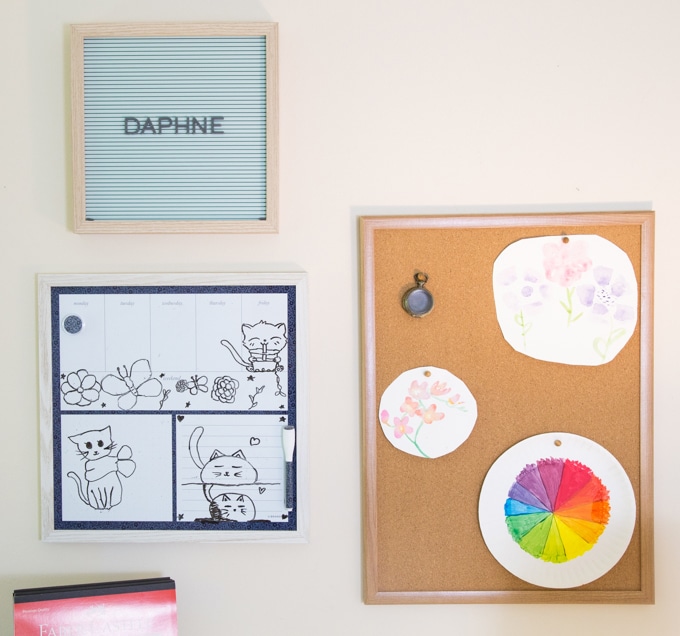
7. Personalize Your Child’s Homework Station
Help kids feel excited about their learning area by personalizing it with their name, artworks, photos of friends and family, and more. Here are some ideas to consider:
- The child’s artwork, perhaps in a special frame that doubles as storage and makes it easy to add new artworks
- Their name
- A message board
- Photos of friends
- Photo of the teacher
- Photo of the child’s classmates
- Family photo
- A special note from a friend, teacher, or family member
- Inspirational quote
That’s a lot of ideas that we’ve just shared! But they’re just that. Ideas. Use them as a starting point as you create learning stations that work for your kids, your family, and your budget.
Want a printable guide with ideas and checklists to help you assess and adjust your current virtual learning desk area or to set up a learning station from scratch?
Get the Free Printable Guide

CLICK HERE to get the Free Printable Guide!
I put together a printable guide and checklist to help you as you set up for virtual learning with your child’s homework station. It includes ideas and guidelines for different ages as well as school and art supply checklists. You can download it for free with the link above.
This post is sponsored by Faber-Castell USA and some of the Faber-Castell supplies pictured were sent to us for free for the post. I only promote products I love and believe will be of value to you as well. All opinions expressed are my own.
Pin It For Later

Related Posts
-
Drawing for Kids: Encouraging the Reluctant Artist
Updated June 2022 We often get asked about drawing for kids and specifically on how to…
-
How to Make Garden Wish Flags
Learn how to make simple garden wish flags with kids using fabric crayons and fabric.…
-
How to Make Mandala Art Designs on Records
Upcycle a vinyl record and glue on loose parts to make these beautiful mandala art…

